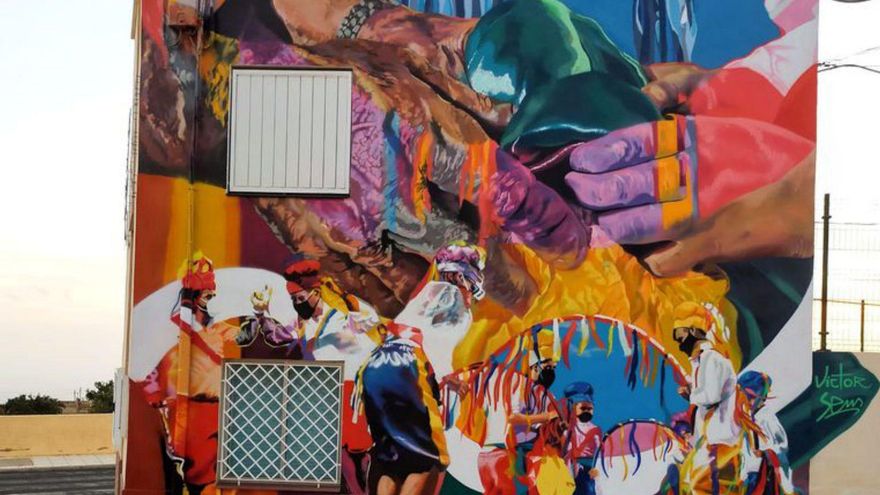
Víctor Seus from Laguna began his journey in the world of murals through graffiti. His style evolves until it reaches experimental painting, where people can express themselves freely through colors and brushes. Rap is also part of his need to tell stories.
Behind the alias Víctor Seus hides the lagoon man Víctor Yeray Hernández. Graduated in Fine Arts, his beginnings date back to the time of graffiti, in 1999, when muralism was not yet considered something legal or well seen. For Seus, art was not relevant in his life, however, he connected with people on the streets who did share artistic concerns and joined them to bomb or graffiti letters. Social transformation through art is one of the aspects that the artist works on together with the design of experiences and education. “Part of my works has to do with pedagogy, which are more individual murals,” he says. Many of the first works that he created, located in La Verdellada, in Barrio Nuevo, and in Guamasa, no longer exist due to their age. His talent has flown to countries like South Korea, where he settled for half a year, Portugal, France and, of course, Spain.
At Seus, creativity when creating a mural comes from many aspects. His modus operandi is to get to know the place, observe the connections and colors on the wall, and also analyze the environment to see if there are many people around or not. “There are many things to take into account. If there is an institute, for example, first you have to see what happens there, what problems they have, what they need to solve and how you can connect with the community where you are”, comments the author. Among his most relevant works, is the one he made on the occasion of Children’s Day, located in the board. “It was a piece that was designed before I got there and I connected a lot with that space,” he says. When it comes to capturing his ideas, the muralist conceives a sketch that, in general, takes a long time to finish. “There are times when it is from one day to the next, but there are times when it can even take a year to finish it,” he says.
The popularity of murals has reached such a point that public administrations see it as a way to beautify streets and building facades. In the beginning, this practice was illegal, but now, institutions support this type of art. “Little by little it began to open up, to the point that urban art is already being assimilated by society and institutions are beginning to support this type of project.” The artist began to receive great support from 2016 and has made a great effort to value the work done by professionals like him.
At the beginning, above all, Víctor Seus used his works as a tool of protest. Many of his works start from a claim base that, on occasions, can be painted with a specific intention, but then opens up to others. «The piece I did at the CEIP Prácticas Aneja talks about mobility, but really there are a lot of children who run out into the street and, now, it just so happens that there is a serious situation with child poverty in Canary Islands», he declares. All this has its germ in graffiti, a practice in which the artists began and from which they evolved. For Seus, graffiti is a priceless philosophical movement. For this reason, society has classified it as a synonym of problem and illegality. “On the one hand, the name is changed to urban art to absorb the negative energy that the concept of graffiti has on a social level and, on the other, it is transformed to create something that produces value for society.”
Víctor Seus also makes experimental murals in collaborative projects with different institutions. Recently, this artist, together with the students of the CEIP La Laguna Infant and Primary Education Center, in Los Llanos de Aridane, created a creative mural using skateboards, balls and wheelchairs as canvas and brush. The objective of these murals is to encourage the creative participation of the true protagonists of this work, in which a result full of colors and experiences is obtained.
















